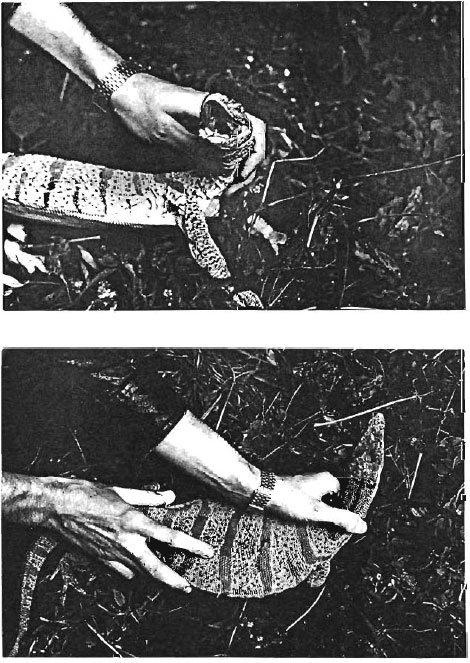Introduction to Keeping Monitors in Captivity
So far, this section has been primarily concerned with the lifestyles of monitor lizards in their natural environments. Over the last 50 years vastly improved communications between continents and the emergence of relatively cheap power in the forms of gas and electricity have made it possible to keep reptiles alive anywhere in the world. Monitor lizards are particularly rewarding animals to keep in captivity because of their intelligence and formidable appearance. But the size attained by many species, including almost all of the easily available monitors, mean that their successful maintenance is dependant largely on the amount of space that is available to them. Providing they have adequate room to move, most are quite undemanding creatures. Before discussing their care, a few words on the ethics and general principles of keeping wild animals in captivity are in order.Keeping Monitors Successfully
The following topics are dedicated to keeping monitor lizards successfully in captivity. "Sucessfully" does not mean that the animals merely live a disease-free existence until old age causes their ultimate demise. It means that all the functions of life are performed by the animals as they would be in nature, including reproduction. In my opinion, it is irresponsible to keep wild animals such as monitor lizards in captivity without at least attempting to breed them. Whilst keeping monitors alive in captivity, though not always an easy task, is one that is quite often accomplished, getting them to breed is still a rare occurrence and as such, it is the ultimate challenge to all keepers of these magnificent creatures.
 |
| Above & Below (top): Correct way to hold a small or medium monitor (MJ.Bennett) Below (bottom): Incorrect way to hold a large monitor. The left hand should grip the back of the head from above. Even thick gloves do not protect wrists against fearsome claws. |
Monitor Lizards & International Law
Nearly all countries are signatories of the CITES convention which concrols the trade in animals and plants considered to be vulnerable to commercial exploitation. All species of monitor lizard are afforded protection under this legislation. It is not lawful to transport the animals across international boundaries without a CITES export certificate from the country of origin and a CITES import certificate from the country of destination. In order to obtain these certificates you must satisfy the authorities that the animals are in your possession legally. Commercial trade in species listed on Appendix I of the CITES regulations is totally outlawed and permits only given for their export and import for other purposes under exceptional circumstances. Five Asian monitor lizards are included on Appendix I: the Komodo Dragon, Gray's monitor, the Bengal monitor, the Caspian monitor and the yellow monitor. All other species are listed in Appendix II. Commercial trade is allowed, but all specimens must carry CITES documentation. Failure to comply with CITES regulations results in automatic confiscation of the animals and punishments ranging from fines to imprisonment Buyers of monitor lizards should always get a copy of the CITES import certificate authorising their import. If the lizards subsequently breed and you want to sell the youngsters abroad you will be expected to prove that they are captive bred and that the parent animals were legally imported. Some countries, notably Australia, only rarely issue export permits for wild animals and never for commercial trade (however see Hoser (1993b) for a fascinating account of the illicit crade in Australian wildlife). Goannas reach the rest of the world either for research and breeding exchanges between institutions, or illicitly. Luckily many specimens are intercepted at borders and passed on by the authorities to zoos and individuals who succeed in breeding them. Captive born Australian monitors with CITES certification fetch very high prices. In addition to CITES regulations local laws may impose separate rescrictions or even prohibitions on the import and keeping of certain monitor lizards.
 |
The Shorter Oxford English Dictionary defines a pet as "any animal that is domesticated or tamed and kept as a favourite, or treated with fondness". Monitor lizards can certainly not be domesticated. If you allow one the run of your home it will cause untold damage without showing the slightest remorse. If you let it out of the house it is highly unlikely that it will ever come back of its own accord. They can be tamed in as much as some individuals will eventually learn to tolerate gentle handling without showing aggression (especially when deprived of sunshine and fresh air), but expecting them to obey any commands, or show the slightest affinity for anything but other monitor lizards is unreasonable. Monitor lizards are ancient, intelligent and beautiful creatures capable of living "happily" in captivity for many years, but to describe them as pet animals would be misleading.
Safety
Monitor lizards survive by catching, killing and defending themselves against other animals. Therefore they are equipped with sharp teeth, strong jaws and powerful claws. Only adults of a few, very large, species have the potential to inflict serious injuries on people but all monitors can inflict scarring wounds and they should always be treated with caution. The most common wounds inflicted by monitor lizards are scratches to wrists and forearms whilst the animals are being handled. The tail is used as a whip in defence and can be mobilised with great speed and force. But the jaws are of the greatest concern. They sink through flesh to the bone and then shake with all their might.
Handling wild animals is not something you can learn from a book. Herpetological societies always have members who are happy to share their expertise. Wild monitors should not be handled without a pair of stout gloves that afford protection to the wrists. They should be seized from above by grabbing the back of the head and the base of the tail in one movement, so that the lizards cannot turn to bite. Obviously very large specimens should be restrained with a noose and require more than one person to lift them. Lifting the lizards by the tail is a very bad practise that can result in injury to either party. Animals kept inside are often much more docile than those kept in open air. Ditmars (1910) records an incident in which some very docile water monitors were moved outside for the summer whereupon they immediately reverted to their wild 'state, attacking their keeper at every opportunity. Once deprived of fresh air and sunshine they soon became placid and friendly again.
"Taming" Monitors
Well-kept monitor lizards do not require any grooming. If their toenails become too long and need to be cut this should be taken as an indication that the furnishings in the enclosure are unsuitable. Dead skin should come off of its own accord. If it needs to be pulled off this indicates that some environmental parameter (probably humidity) is incorrect. Some of the people who have had most success with breeding monitor lizards consider it important that the animals do not get used to being handled and are allowed plenty of privacy. One obvious reason for this is that monitor lizards show their dominance to weaker individuals by rubbing their backs or lying on top of them. A monitor lizard that is handled in this way assumes the role of a subordinate animal and may be less likely to initiate or respond to courtship. However, in the family environment the lizard keeper may feel that it is in their interests that the lizards tolerate gentle handling by themselves, their parents or their children. The irrational fear of reptiles experienced by many unfortunate people often vanishes when they touch one and realise that it is warm and dry rather than slimy and cold. When monitor lizards are used to being handled they are much less inclined to struggle and bite. Individuals used to humanity from a early age are sometimes extremely docile. The process of taming some monitor species is neither dangerous nor difficult if the animals are obtained as juveniles. Individual monitor lizards have very different temperaments and many will become placid, almost friendly , in human company. However is not a total guarantee of safety, and large specimens should be treated with caution at all times, regardless of their disposition. The monitor keeper who is admitted to hospital as a result of his or her carelessness does little to enhance the popular perception of reptiles.
To tame a monitor lizard it should be handled regularly. Wash your hands to remove all scents that might be interpreted as edible and hold the monitor firmly It will struggle at first. but should eventually settle down. Some monitors enjoy being scratched gently; under the chin, above the eyes, and particularly behind the ear. They almost seem to show their pleasure by dosing the eyes and breathing deeply. After a while one gets used to a particular monitor's erogenous zones and the taming process becomes easier. There is a sensation associated with tickling an enormous water monitor under the chin that is difficult to describe! If they do get annoyed they will usually give ample warning by hissing and inflating the throat before resoning to violence. In this case, leave them for a day and try again .
Never handle a monitor while it is digesting large meals and never attempt to tame large animals unaccustomed to people. The more they are handled as youngsters, the tamer they will be as adults, but it is important to continue to handle the monitor regularly throughout its life, lest it forgets. Very large monitor lizards have the potential to inflict horrendous injuries and they should always be treated with caution. All monitors react to smell, and approaching a large male whilst bearing the scent of a rival could give you more than you bargained for.
>Attribution / Courtesy: Daniel Bennett. 1995. A Little Book of Monitor Lizards. Viper Press U.K.




